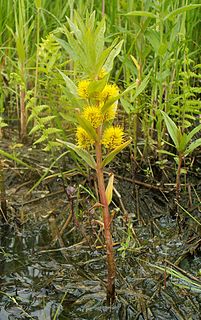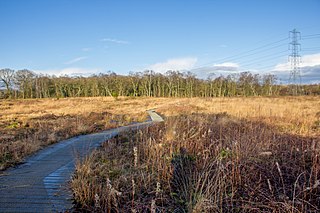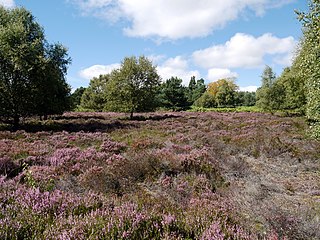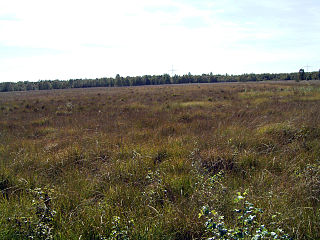Related Research Articles
This article gives an overview of the mire plant communities in the British National Vegetation Classification system.
NVC community W3 is one of the woodland communities in the British National Vegetation Classification system.
NVC community M1 is one of the mire communities in the British National Vegetation Classification system.
NVC community M2 is one of the mire communities in the British National Vegetation Classification system.
The Portlethen Moss is an acidic bog nature reserve located to the west of the town of Portlethen, Aberdeenshire in Scotland. Like other mosses, this wetland area supports a variety of plant and animal species, even though it has been subject to certain development and agricultural degradation pressures. For example, the Great Crested Newt was found here prior to the expansion of the town of Portlethen. Many acid loving vegetative species occur in Portlethen Moss, and the habitat is monitored by the Scottish Wildlife Trust.
NVC community H5 is one of the heath communities in the British National Vegetation Classification system. It is one of three communities which are considered transitional between the lowland dry heaths and the wetter communities classified in the NVC as mires.
NVC community CG10 is one of the calcicolous grassland communities in the British National Vegetation Classification system. Of the upland group of calcicolous grasslands, it is the only one with a short sward associated with heavy grazing.

Cors Caron is a raised bog in Ceredigion, Wales. Cors is the Welsh word for "bog": the site is also known as Tregaron Bog, being near the small town of Tregaron. Cors Caron covers an area of approximately 349 hectares. Cors Caron represents the most intact surviving example of a raised bog landscape in the United Kingdom. About 44 different species groups inhabit the area including various land and aquatic plants, fish, insects, crustaceans, lichen, fungi, terrestrial mammals and birds.

Lysimachia thyrsiflora, the tufted loosestrife, is a plant in the genus Lysimachia. It is native to large sections of the northern Northern Hemisphere, including Eurasia and North America. It often grows in marshes, shorelines of lakes and ponds and occasionally along streams. It is an erect perennial herb growing up to 80 centimeters tall and bearing yellow flowers, sometimes dotted with purple. It may be confused with purple loosestrife when not blooming but can be easily distinguished because purple loosestrife has a square stem. Tufted loosestrife has been used medicinally in Asia to combat high blood pressure.

Aulacomnium palustre, the bog groove-moss or ribbed bog moss, is a moss that is nearly cosmopolitan in distribution. It occurs in North America, Hispaniola, Venezuela, Eurasia, and New Zealand. In North America, it occurs across southern arctic, subboreal, and boreal regions from Alaska and British Columbia to Greenland and Quebec. Documentation of ribbed bog moss's distribution in the contiguous United States is probably incomplete. It is reported sporadically south to Washington, Wyoming, Georgia, and Virginia.

Pow Hill Bog is a Site of Special Scientific Interest in the Wear Valley district of County Durham, England. It lies alongside Derwent Reservoir, approximately 2 km north-west of the village of Edmundbyers and adjacent to the Edmundbyers Common portion of the Muggleswick, Stanhope and Edmundbyers Commons and Blanchland Moor SSSI.

Danes Moss Nature Reserve is a 13.4-hectare (33-acre) nature reserve south of Macclesfield, Cheshire, England. A Site of Special Scientific Interest, it is managed by the Cheshire Wildlife Trust.

Carex bigelowii is a species of sedge known by the common names Bigelow's sedge, Gwanmo sedge, and stiff sedge. It has an Arctic–alpine distribution in Eurasia and North America, and grows up to 50 centimetres (20 in) tall in a variety of habitats.

Sphagnum squarrosum, commonly known as the spiky bog-moss or spreading-leaved bog moss is a species of moss which grows in nutrient-rich, damp soil. Typical habitats include woodland, the banks of streams and ditches; it can even be found at high altitude in damp cirques. The species often grows near sedges (Carex), rushes (Juncus) or purple moor grass.

Allendale Moors is a Site of Special Scientific Interest (SSSI) in Northumberland, England. The upland moorland ridge site is listed for its heath, flush and upland grassland which provide a habitat for a nationally important assemblage of moorland breeding birds.

Bewick and Beanley Moors is the name given to a Site of Special Scientific Interest (SSSI) in north Northumberland, in the north-east of England. The moors are asserted to be of national importance by Natural England for the extent, quality and diversity of upland types including heaths, fens, wet grassland, flushes, mires and blanket bogs, together creating an extensive mosaic habitat supporting an exceptional community of amphibians. The moors are important, too, for their relict juniper woodland and scrub.

A floating mat is a layer of mosses and other, especially stoloniferous, plants that grows out from the shore across the surface of a lake or pond. This type of habitat is protected and is designated in the European Habitats Directive as "LRT No. 7140 Transition and Floating Mat Bogs".

Wellington College Bog is a 6.2-hectare (15-acre) biological Site of Special Scientific Interest in the grounds of Wellington College on the northern outskirts of Sandhurst in Berkshire.

Salta Moss is a raised blanket mire which is a Site of Special Scientific Interest ('SSSI') located in the hamlet of Salta, in Cumbria, United Kingdom. It was determined to be of biological interest under the Wildlife and Countryside Act 1981. The site, measuring 45.6 hectares, was officially designated in August 1982.
References
- Rodwell, J. S. (1991) British Plant Communities Volume 2 - Mires and heaths ISBN 0-521-39165-2 (hardback), ISBN 0-521-62720-6 (paperback)